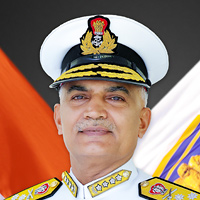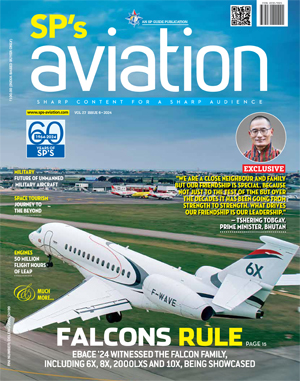INDIAN ARMED FORCES CHIEFS ON
OUR RELENTLESS AND FOCUSED PUBLISHING EFFORTS

SP Guide Publications puts forth a well compiled articulation of issues, pursuits and accomplishments of the Indian Army, over the years

I am confident that SP Guide Publications would continue to inform, inspire and influence.

My compliments to SP Guide Publications for informative and credible reportage on contemporary aerospace issues over the past six decades.
Is the IAF Equipped for Two-Front War?
Reequipping the IAF with more AWACS, aerial tankers, upgrading Su-30 MKI fleet and acquiring adequate airborne recce assets, will make the IAF more capable of coping with a two-front war

India’s relations with China are deteriorating rapidly and could result in a war on the Northern border. In such a scenario, employment of the Indian Air Force (IAF) will become inevitable. It is also possible that Pakistan may open another front against India in coordination with China. Pakistan could also permit People’s Liberation Army Air Force (PLAAF) fighter aircraft to undertake airstrikes against India from their air bases, which amounts to an act of war. Is the IAF equipped to handle a two-front war?
COMBAT FLEET
Against a sanctioned strength of 42 fighter squadrons, the IAF presently has 30. With two squadrons of Rafale jets and one MiG-29 squadron under induction, the strength will increase to 33 squadrons, consisting of MiG-21 Bison, Jaguar, Mirage 2000, MiG-29, Su-30 MKI and Tejas light combat aircraft. The MiG- 21 Bison, Jaguar, Mirage 2000 and MiG-29 have all undergone mid-life upgrades which involved embedding their avionics with superior technology to add new weapons, improve weapon payload, weapon delivery accuracy, navigation and radar capabilities, categorising these as fourth generation aircraft. The Rafale with AESA radar is a fourth plus generation fighter aircraft. The legendary J.R.D. Tata, headed a committee in the early 1960s which recommended 65 combat squadrons for the IAF to face a three-front war against West Pakistan, East Pakistan and China. However, the government sanctioned only 39.5 fighter combat squadrons, a figure that was later revised to 42 squadrons.
With the exception of MiG-21 Bison, all combat aircraft in the IAF today have in-flight refueling capability, which enhances their operational range. The IAF has 12 squadrons of Su-30 MKI that is superior to MiG-21 in weapon payload capability, combat radius and in-flight refueling capability. While the Su-30 MKI can carry 8.5 tonne weapon payload, the MiG-21 Bison carries only two tonnes of armament. Therefore, in terms of firepower, one Su-30 MKI is as good as four MiG-21 Bisons.
Catering for low weapon carrying capability, large Circular Error Probable of weapons, earlier days, a formation of MiG-21 on ground attack mission, had to be escorted by air defence and electronic warfare (EW) aircraft. Today, both the Su-30 MKI and Mirage 2000 carry heavier weapon loads and deliver with greater accuracy. These aircraft carry integral air defence weapons with self-protection EW equipment, obviating the need to have supporting aircraft for a mission. As the present 12 Su-30 MKI squadrons are effectively equivalent to 24 MiG-21 Bison squadrons if not more, the size of the formation of Su-30 MKI/Mirage 2000 for a ground attack mission against enemy targets, can be reduced significantly. The IAF therefore should not assess its existing capability based on number of aircraft/squadrons; but by the weapon load it can accurately deliver against enemy targets. Today, the IAF’s fighter fleet is far better equipped, the crew are well trained and field state-of-the-art weapons.
ATTACK HELICOPTERS
The attack and airlift helicopters will add immense muscle to the Indian armed forces. The IAF has 22 Apache AH-64E attack helicopters that are capable of delivering significant air-to-ground weapons especially in the mountainous terrain. It carries a 30mm cannon, Hellfire AGM-114 Anti-Tank missiles, Stinger air-to-air missiles, the AGM-122 Sidearm anti-radiation missile and the MBDA Brimstone anti-armour missile. This helicopter is designed for day and night operations and is considered a “game-changer” in the tactical battle scenario.
The IAF’s Soviet Mi-35 attack helicopters, Advanced Light Helicopter (ALH) Rudra WSI and Light Combat Helicopter (LCH) produced by Hindustan Aeronautics Limited (HAL), are all capable of providing effective tactical support in the battle area to ground forces. Even the large force of Mi-17 V-5 helicopters can also be used in offensive role. Thus, the IAF has a potent helicopter force, significant in number and well trained. These helicopters supplement the ground attack aircraft especially in the forward edge of battle area and provide a boost to the IAF’s operational capability. Attack helicopters will effectively reduce the number of fighter aircraft that would have been required in case of two-front war.
FORCE MULTIPLIERS
We need to consider the force multipliers that have been acquired by the IAF since the 1960s. The IAF’s acquisition of the Airborne Warning And Control System (AWACS) and indigenous Airborne Early Warning platforms are effective ‘force multipliers’ that will strengthen aerial combat capability and provide cover for the attack missions well into enemy territory, thus enabling optimum employment of combat aircraft. However, the IAF needs more AWACS aircraft to cover the entire Western and Northern borders and the government has initiated acquisition of more AWACS aircraft post the recent Chinese intrusion in Ladakh. It is estimated that the IAF would need 20 AWACS aircraft to cover its borders. The induction of IL-78 aerial tankers in 2003 and also the buddy refueling capability of Su-30 MKI aircraft, have been another ‘force multiplier’, effectively increasing optimum utilisation of available aircraft and provide defence in depth. There is also the need to add more aerial tankers to cover the large border areas facing the enemies. These force multipliers as the name suggests, will make the number of squadrons or aircraft not the overriding factor in case a two-front war.
AIR DEFENCE MISSILES
The IAF has deployed the SPYDER Surface-to-Air Missile (SAM) acquired from Israel as also the indigenous Akash SAM that has a range of 30 km. These air defence systems have been deployed in Ladakh along the India-China border in accordance with strategic planning for a double layer air defence to safeguard high value and militarily critical resources of the country. India is also acquiring the Russian S-400, the most advanced long-range air defence missile system that is designed to destroy aircraft, cruise and ballistic missiles, including medium-range missiles and can also be used against ground installations. It can engage targets at a distance of 400 km and at an altitude of up to 30 km.
PAKISTAN AIR FORCE
The Pakistan Air Force (PAF) has about 450 fighter aircraft, of which the only potent fleet is that of 18 F-16 Block 52. It has in service the JF-17 Block I and II and the more potent JF-17 Block III is on order and is expected to be inducted in the near future. Russia supplies RD-93 engines for JF-17 and PAF is reportedly facing serious supply and maintenance issues. The PAF’s main combat fleet in the long run will be F-16s and JF-17s. There are currently 22 front-line squadrons operating from 13 flying bases. PAF’s F-16 fleet has been upgraded with modification kits by Turkish Aerospace Industries starting 2010. Presently, PAF faces serious issues with maintenance and serviceability of their fleet. Other than the F-16, aircraft of the PAF are old and qualitatively inferior to the IAF fleet. Serviceability and operational utilisation of JF-17s are issues of concern to China and Pakistan. Mirage variants and F-7P (MiG-21 variant) suffer from poor maintenance due to acute shortage of spares. PAF capability to support ground forces is severely limited due to insufficient numbers in their inventory. In the prevailing geo-strategic scenario, PAF is unlikely to acquire any modern 4th/5th generation fighter from Western countries.
THE PLAAF
The PLAAF has more aircraft than the IAF, but China has multiple flash points to cater for such as South China Sea, Eastern sector against Japan, Tajikistan in the West, Mongolia in the North and hence will not be in a position to employ all its aircraft against India. As per Belfer Centre for Science and International Affairs in Harvard Kennedy School, “The IAF is more powerful than the PLAAF”.
Some think tanks are of the view that China will be able to deploy only around 20 per cent of its aircraft against India, as China’s primary focus is Taipei and South China Sea besides Japan. This is probably the reason that China is moving SAMs to Ladakh to cover the gaps on account of inability to deploy fighter aircraft. China has problems with Vietnam, Tajikistan and also Mongolia. Serviceability of Chinese aircraft is also badly affected by disruption of supplies from Russia. For air support to Chinese ground forces, most of the airfields in Tibet region are at high altitude that will limit the weapon load and fuel Chinese aircraft can carry, thus limiting their effectiveness. Most the Chinese airfields are within striking range of IAF aircraft and hence can be put out of operation quite easily. In the area of missiles, China certainly has an edge over India.
THE FINAL WORD
The concept of numerical superiority in aerial warfare undergoes transformation with advanced technologies and mid-life upgrades of aircraft. While efforts must be sustained to restore the strength of the combat fleet to its authorised level of 42 squadrons, which does not appear to be easy, even with the somewhat depleted strength, the IAF has adequate number of aircraft to cope with a two-front war. Meanwhile, reequipping the IAF with more AWACS, aerial tankers, upgrading Su-30 MKI fleet and acquiring adequate airborne recce assets will make the IAF more capable of confronting the challenges of a two-front war.





